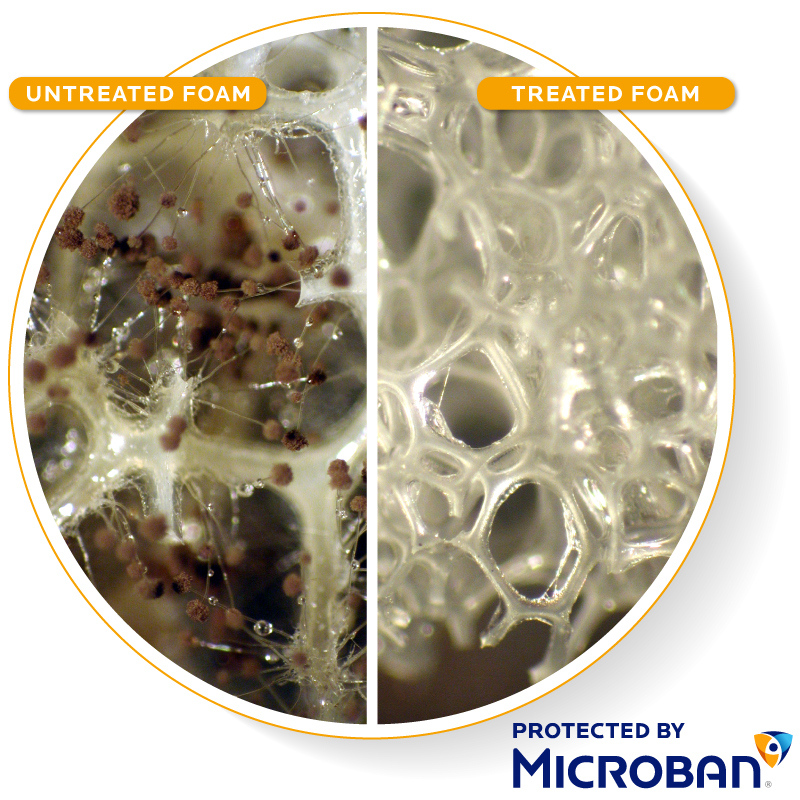Meet Microban’s foam expert, Rich Kenney

Rich Kenney
Rich Kenney, Microban's Director of Business Development, leads the Company’s efforts in the foam industry and works with leading manufacturers in North America to guide growth and product development.
With a proven track record of pioneering initiatives, Rich has counseled Microban brand partners through navigating the complex antimicrobial landscape and the challenges of both international and domestic market shifts in the foam industry.
Q: What are the most significant trends currently shaping the PU foam industry?
A: The PU Foam industry has been working to highlight the positive changes it has made over the years to improve the chemistry used in making PU Foam and enhance product sustainability and broader sustainability initiatives. In 2008, CertiPUR.US was formed to help highlight these changes and create a standard that provides consumers with peace of mind, knowing that CertiPUR.US foam adheres to strict standards. Microban antimicrobial additives are used in CertiPUR.US foams and help bring positive features of lasting freshness and sustainability to treated PU foams.
Q: What are the primary applications or industries where PU Foam is commonly treated with Microban antimicrobial additives?
A: Multiple applications benefit from Microban foam treatments. These include:
Pillow foam
Marina foam
Automotive foam interiors
Carpet pad foam
Q: In what ways do Microban technologies contribute to the overall sustainability of PU foam applications?
A: Microban antimicrobial treatments actively inhibit microbial growth in foam, reducing odors, maintaining aesthetic appeal, and extending product life. This contributes to reduced energy & resource consumption and lower landfill loading.
Q: How does Microban assist PU foam manufacturers in optimizing formulations to achieve desired antimicrobial efficacy without compromising product performance?
A: We are confident in our technology portfolio's ability to be incorporated into PU Foam. Microban products are engineered to be easily incorporated into the PU Foam manufacturing process.
Additionally, Microban has a state-of-the-art testing and innovation facility that provides our customers with ongoing testing. We work with many clients to help develop specific testing to review quality for their particular needs, and we offer ongoing standard assessment testing, providing our customers with peace of mind that Microban-treated goods meet or exceed industry standard requirements such as ASTM G21, ASTM E1428, and many other test specifications.
Q: How does Microban collaborate with industry associations to foster knowledge-sharing and best practices in antimicrobial solutions for PU foam?
A: We maintain open communication with our partners, attend industry events to stay informed, and present test methods and new products designed for PU Foam. We also participate in several foam associations worldwide, including the Polyurethane Foam Association (PFA), Carpet Cushion Council, and the CPI. This allows us to establish solid relationships with manufacturers and suppliers in the foam industry and stay educated on market trends.
Microban will routinely be called upon to present our expertise to industry groups, discussing topics such as Antimicrobial testing, regulation, and innovation in the industry.
Q: What emerging challenges or opportunities do you see for the PU foam industry, and how is Microban positioned to support manufacturers in navigating these changes?
A: Recycling is a major challenge for the foam industry.
Both mattress and carpet cushion sectors are under pressure to establish recycling programs in North America. Recent legislation in New York State explicitly mandates the recycling of materials in the flooring industry, including carpet cushions, posing significant challenges for manufacturers in navigating this new law. Microban International actively assists the industry by offering manufacturers support in enhancing the sustainability of their foam materials. We achieve this by keeping the foam materials cleaner and fresher for longer. This, in turn, reduces the amount of waste generated and increases the chance of recyclability due to the cleanliness of the foam materials.
Sustainability is also a central talking point in the industry. We believe that Microban has always provided a sustainability advantage to our customers. Foam is an excellent home for microbes to grow and flourish. For example, mattress foam (without Microban protection) is the perfect environment for mold and mildew growth due to the humidity and moisture present.

By applying Microban antimicrobial treatment to the mattress, you can prevent the growth of mold and mildew. This treatment also helps maintain the mattress's cleanliness and freshness over time. As a result, the mattress stays in use longer, reducing the need for premature disposal.


